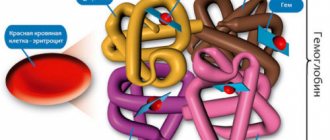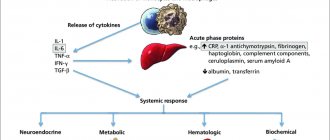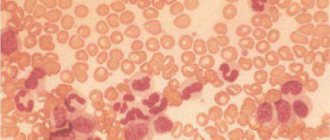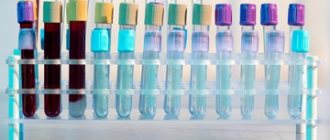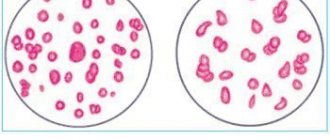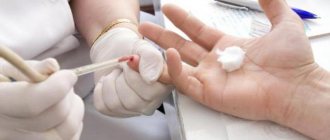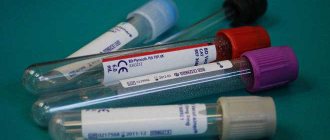General information about the MCH test
The mch (Mean Corpuscular Hemoglobin) indicator in the analysis refers to the red blood cell index. It is calculated during a laboratory blood test to identify diseases. Such diagnostics are performed in regular clinics. The saturation of the body's cells with oxygen depends on the content of red blood cells and the mass of hemoglobin in them.
Attention! If MCH is increased in a red blood cell, the blood will become thick. This often leads to the development of thrombosis. When the level is low, oxygen starvation of the body is assumed.
Similarly, when a general blood test shows increased or decreased hemoglobin, this is considered a deviation from the norm and indicates the development of pathology. Additional examinations are required to make a final diagnosis. When a doctor prescribes a determination of the mch index in a blood test, he will immediately explain what it is. In medicine, the study determines the average hemoglobin content in one red blood cell and the level of iron absorption by the body.
The index is determined according to two criteria:
- Amount of hemoglobin in g/l.
- Red blood cell count.
Next, the calculation is made using a simple formula. To do this, the hemoglobin indicator is divided by the number of red blood cells and multiplied by the standard given number (10-12). On average, the hemoglobin content in an erythrocyte mch is measured in pictograms, which is determined in the analysis results by the PG value.
Decoding the results. How is MSN calculated?
A printout of the tests is intended for the attending physician who issued the referral. But this does not mean that a person cannot independently understand his own health indicators. Therefore, it is important to understand what the numbers and letters on the printout mean.
- MCH in a blood test is the level of hemoglobin in a red blood cell. A more accurate indicator of CPU, giving a definition in pg. The norm for an adult is 25-32 pg.
- The hemoglobin content is designated as hemoglobin, Hb or HGB. Nearby are numbers that indicate the level that can be compared with the norms.
- Red blood cells are designated er, RBC or red blood cells. The readings give an idea of the level of red blood cells in the blood. It is red blood cells that contain hemoglobin, which transports oxygen throughout the body.
- CP or color indicator - the amount of hemoglobin in red blood cells. The norm is 0.8-1.15.
- Erythrocyte index (MCV). Hemoglobin level in red blood cells. The norm is 80-100.
There are more indications in the transcript, but in this situation MCH is of interest. You should not make hasty conclusions based on your own guesses based on the testimony. It is better to entrust this to specialists.
When is a test ordered?
The index in question is determined during a general blood test. The rate at which oxygen is transported to various cells throughout the body depends on the number of red blood cells and their hemoglobin content. The result is determined by the formula indicated earlier.
With a normal level of health and the absence of pathologies, the index fluctuates between 24-34 pg. Indicators are unstable in young children. Adult patients, regardless of gender, show stable results. There are no specific indications for this analysis; a miscalculation is always made when a UAC is performed.
What is hematocrit?
The hematocrit number, or hematocrit, is one of the indicators calculated in a blood test. Hematocrit is the ratio of red blood cells to the total blood volume in the body. Symbol in the HCT form in the blood test.
The short name “hematocrit” originates from the name of the analyzer flask for the study. Another name that works for hematocrit would be “thickness.” In some sources, the indicator is defined as the ratio of cells to total blood volume.
This indicator can be determined visually by pouring some blood into a test tube. When it settles, you can see two layers - a dark layer of settled cells and a light layer of blood plasma. The percentage of layers will be a rough example of how to calculate the number required.
What does HCT mean in a blood test? This is an indicator of hematocrit, which determines the level of red blood cells in the total volume, where they make up 99%.
Features of MCH analysis
Throughout life, the average content of hb (hemoglobin) in a person’s red blood cell changes. The highest indicator is determined in infants (within 30-37 pg.). By the age of twelve months the numbers drop to 24-30 pg. In adolescence, the index is 26-34 pg.
Subsequently, if the person remains healthy, the mch level in the blood does not change until the age of 65 years. Pensioners are diagnosed with many chronic diseases, so many indicators in a blood test change, including the average hemoglobin (Hb) content in a red blood cell.
Attention! Blood sampling is performed by a doctor in a polyclinic laboratory, observing sterile conditions.
For girls and men aged 18-45 years, the indicator is in the range of 27-34 pg. Normally, women experience a change in average values from 45 to 65 years due to the onset of menopause. To perform the study, blood is taken from a finger, as with OAC. The procedure is virtually painless and does not require special preparation.
Hct blood test decoding for children
IMPORTANT! To save an article to bookmarks, press: CTRL + D
DOCTOR, and get a FREE ANSWER, you can fill out a special form on OUR SITE, follow this link >>>
Blood test: deciphering HCT in children, women and men
A blood test is one of the most important research methods, as it allows the doctor to obtain the necessary information about possible diseases. If your doctor thinks you have too many or few red blood cells, he or she may order an HCT test. So: blood test, HCT decoding, norm and deviations.
HCT blood test: interpretation, normal
Blood consists of water, plasma and cellular components. It is these blood cells that we will talk about. There are three main groups of blood cells - the so-called formed elements:
- erythrocytes - red blood cells responsible for saturating body tissues with oxygen and nutrients;
- leukocytes, which provide protection against foreign cells and pathogens;
- platelets responsible for blood clotting.
The HCT indicator in a blood test indicates the proportion of all cellular components in the blood volume and is called hematocrit. Since the composition of blood cells is dominated by erythrocytes, which account for approximately 99% of all cells, the hematocrit is largely determined by their concentration.
Our body relies on the correct proportion of red blood cells in the blood to stay healthy. Studying the hematocrit level will help the doctor diagnose certain changes in the body or confirm the assumption of a disease, and provide information about the patient’s water balance. An HCT test can also help determine how well our body responds to a certain treatment.
The analysis is done for various reasons, but most often it is used to check for the presence of such pathologies:
The HCT indicator can be determined either as a result of a general or complete blood test. A complete analysis also examines the level of hemoglobin and reticulocytes, young red blood cells. The doctor will look at your overall blood test results to get an idea of your red blood cell concentration.
A laboratory hematocrit test will require a small amount of blood. Blood is collected by pricking a finger or using a syringe from a vein in the arm.
If the hematocrit test is part of the complete analysis, blood from a vein will be used.
In the laboratory, the biological material is placed in a centrifuge, where the tube rotates at high speed, due to which the blood is divided into three parts, such as:
- plasma is the liquid component of blood;
- red blood cells;
- an anticoagulant that is added to prevent blood from clotting.
Red blood cells are concentrated in the lower part of the tube, they are compared with the reference value, as a result of which the blood HCT indicator is determined. Normal hematocrit levels depend on the gender and age of the patient.
When deciphering the HCT blood test, the norm for women is in the range from 34.9 to 44.5%. For adult men, the generally accepted HCT ranges are 38.8% to 50%. Children under 15 years of age have a separate set of ranges for HCT reading. This is due to the fact that a child’s hematocrit changes rapidly with age.
The clinical laboratory that analyzes the test results will determine the normal hematocrit range for a child of a certain age. The interpretation of the HCT blood test and the norm in children are shown in the table.
How to prepare for research
Before taking a general blood test, the patient is prohibited from eating breakfast. The collection of biological material is performed on an empty stomach, from 8 to 12 hours. To obtain correct results, you need to follow some rules.
The recommendations are as follows:
- the concept of “on an empty stomach” involves a complete abstinence from eating food, including juices, waters, tea and even the lightest foods;
- on the eve of the study, it is prohibited to drink alcoholic beverages of various strengths the day before the study;
- It is prohibited to consume drinks and foods containing caffeine 12 hours before collecting biomaterial;
- It is not recommended to overload yourself emotionally and physically the day before the analysis.
Important! All proposed recommendations must be followed at least 12 hours before the test, but preferably a day before. The rest of the time, a person may not adhere to a diet and maintain his usual lifestyle.
Indications for testing
MSI in a blood test is a highly informative indicator, thanks to which it is possible to assess the current state of the body, confirm the diagnosis, conduct differential diagnostics and study the dynamics of prescribed therapy. Typically, this test is prescribed at the MedArt clinic for:
- Preventive and clinical observation, including for pregnant women.
- Baseline examination during patient hospitalization.
- Suspicion of anemia (of any type).
- Diseases of the hematopoietic system.
- Infectious and inflammatory processes.
- Evaluation of the effectiveness of the started treatment.
It is important to understand that the MCH is not an independent indicator. To evaluate it, a detailed blood test is prescribed, reflecting the most complete picture of the bloodstream at the moment.
Execution technique
The mch index in the blood is determined after obtaining biological material from the ring finger. The procedure does not take more than 5 minutes and is virtually pain-free. It is recommended to use a disposable, sterile scarifier. It is better to purchase it separately at the pharmacy.
The procedure algorithm is as follows:
- the patient enters the laboratory;
- sits down on a chair and extends his right hand to the doctor;
- the specialist briefly massages the ring finger;
- then the puncture site is treated with an antiseptic;
- after the skin has dried, a puncture is made with a scarifier;
- biological material is collected in a test tube;
- After blood collection, the puncture site is treated again and a cotton swab with an antiseptic is applied to it.
If the test is taken in a small clinic, you can bring a scarifier, sterile gloves and alcohol with you. You need to enter the office without outer clothing (in the autumn-winter period), shoe covers are put on your shoes.
When to expect results
The average waiting time for results to be ready ranges from 30 minutes to two hours. The time frame may increase depending on the technical support and workload of the outpatient laboratory.
The results form indicates the following parameters:
- leukocyte count;
- mchc level in the blood;
- red blood cell rate (ESR).
If the study is extensive, the list of parameters will be different. When taking a CITO test (as an emergency), the results are ready within 10-30 minutes. Often, the results of the analysis are sent immediately to the leading specialist who performs the decoding.
MCH norm indicators
The average amount of hemoglobin in one red blood cell varies depending on age and gender. Its average value in a healthy adult is from 27 to 31 picograms (pg). The highest rates are observed in infants under 14 days of age. They can vary from 30 to 37 pg and, as they grow older, gradually decrease and are compared with the norm for adults. Norms for women
| Woman's age, years | Norm MCH per red blood cell (in pg) |
| 16-18 | 26-34 |
| 19-45 | 27-35 |
| 46-60 | 27-34 |
| After 60 | 27-35 |
The norms for men are approximately the same as for women. Minimal deviations are observed. 46-6027-34 After 6027-35
| Man's age, years | Norm MCH per red blood cell (in pg) |
| 16-18 | 27-32,5 |
| 19-45 | 27-34 |
| 46-60 | 27-35 |
| After 60 | 27-34,5 |
Norms for children. It should be noted that these indicators are unstable; they can change within a matter of hours or days.
| Child's age, years | Norm MCH per red blood cell (in pg) |
| 1-4 months | 27-32 |
| 1-3 years | 23-31 |
| 7-15 years | 26-32 |
Standards for men, women and children
After studying the biomaterial during decoding, laboratory assistants resort to using a table of established standards. This will allow you to obtain reliable information.
| Age | Boundaries of norms |
| Children under 14 days | 30-37 pg |
| Children under 30 days | 29-36 pg |
| Children under two months | 27-34 pg |
| Children under 3 years old | 22-30 pg |
| Children under 13 years old | 25-31 pg |
| Teenagers under 16 years old | 26-32 pg |
| Teenagers under 17 years old | 26-34 pg |
| Men and women | 27-34 pg |
The concentration determines the presence or absence of pathology. If it is increased or decreased, then additional tests are needed.
Reasons for high rates
All results of laboratory tests are recorded on a special form. The decoding is performed by the doctor. If the MCH index in the blood is elevated, this indicates the development of hyperchromia. In this case, the red blood cells contain too much hemoglobin. The concept is general, but defines anemia.
The MCH index increases in the following conditions:
- various diseases of the lungs and respiratory organs;
- smoking experience more than 20 years;
- introduction of doping or stimulants into the systemic circulation;
- living in mountainous areas at high altitude;
- high levels of heparin;
- high content of vitamin B12 in the body.
Hyperchromic anemia often indicates an excess of hemoglobin against the background of a megaloblastic form of anemia. With this disease, there is a lack of vitamin B12 and folic acid in the body. As it progresses, megaloblasts (large cells of atypical shape) develop.
Attention! The reasons that increase the hemoglobin content in red blood cells have a direct relationship with the volume of cells, but not with the concentration of pigment in an individual unit.
Among the concomitant diseases that increase MHC, there are: myelodysplastic syndrome, autoimmune pathologies, HIV infection, epilepsy. Indicators increase as a result of taking certain medications to combat malignant tumors, with hypothyroidism, alcoholism, liver disease, leukemia, and after long-term use of birth control pills.
Reasons for low performance
When a decrease in the index relative to normal values is determined, this means that the patient has hypochromic anemia. Most often it occurs as a result of a lack of iron in the body. The quantitative content of hemoglobin in the blood is determined by the quality of the synthesis of this mineral. With a slow process, its content decreases.
Low rates occur in the following conditions:
- heavy metal vapor poisoning;
- posthemorrhagic chronic iron deficiency;
- disruption of hemoglobin structure;
- hypothyroidism;
- oxygen starvation of body cells;
- hypovitaminosis;
- impaired metabolism as a result of inflammation.
To clarify the diagnosis, the patient is prescribed an MCHC and MCV analysis. With a low hemoglobin index in the red blood cell, a person becomes weak. Gradually, the hair and skin become dry, the skin turns pale, the limbs go numb, arrhythmia develops, and the nails become bent.
What is HCT in blood test
Blood is divided into a liquid part (plasma) and a cellular part (formed elements). The main representatives of the cellular part are erythrocytes (red cells). In clinical hematology, their quantity, designated RBC, sedimentation rate (ESR or ESR), and hematocrit number (HCT) are studied.
Hematocrit or HCT in a blood test is the percentage of red blood cells relative to the total volume of body fluid.
GCA (general clinical analysis) is a method for studying the physical properties and chemical composition of blood, used in laboratory diagnostics.
The study is prescribed to determine possible violations of microbiological processes in the body. Deviations identified during the analysis indicate the development of certain diseases.
Main indicators of OKA
| HB – hemoglobin | Leukocyte formula: NEU - neutrophils, LYM - lymphocytes, MID: (BAS - basophils, EOS - eosinophils, MON - monocytes) |
| RBC - red blood cells | |
| RET – reticulocytes | |
| HCT – hematocrit | |
| ESR – erythrocyte sedimentation rate | |
| WBC - white blood cells | |
| PLT - platelets |
The interpretation of the analysis is carried out by comparing the results obtained and the reference values accepted in clinical hematology for all blood parameters studied.
Hematocrit number
The hemorrhage value reflects the degree of saturation of the blood with red blood cells and their performance. Red blood cells act as a conductor of oxygen from the lungs to body tissues and carbon dioxide in the opposite direction. This is their main function. In addition, red blood cells are responsible for the delivery of vitamins, amino acids, cholesterol and glucose from the digestive system to cells.
Take part in:
- in maintaining the constancy of the internal environment of the body (homeostasis) and the processes of adaptation to biological changes;
- in nutrient metabolic processes;
- in protecting blood vessels from the negative effects of free radicals.
The hematocrit level shows how much the blood is filled with red cells to ensure the full functioning of the body.
Laboratory microscopy
Calculation of the hematocrit number is included in the general clinical blood test.
A separate study of this indicator may be prescribed in case of unsatisfactory results of OKA: anemia (anemia) and high concentration of red blood cells, as well as in case of bleeding of various etiologies (origins), in case of dehydration (dehydration) of the body. HCT is an important indicator of chronic hematological diseases.
To obtain objective final data, on the eve of the study, the patient is recommended to eliminate heavy foods (fatty and fried foods) from the diet, eliminate alcohol-containing drinks, and limit sports and other physical activities. The blood sampling procedure is carried out in laboratory conditions, in the morning.
Before the analysis, it is advisable to give up breakfast and smoking. The hematocrit value is determined using a laboratory device into which a glass graduated tube containing the blood sample being tested is placed. An anti-clotting agent is first added to the biofluid.
Under the influence of centrifugal forces (centrifugation), the blood is stratified. Red blood cells precipitate, clearly demonstrating their volume, and the plasma rises to the top. The remaining formed elements (leukocytes and platelets) are concentrated between them.
Brief scheme for hematocrit allocation
In modern laboratories, the process of measuring red blood cell volume is fully automated. The measurement value of hematocrit in clinical microscopy is taken as percentages or units (% multiplied by a factor of 0.01).
Reference values
The volume of red blood cells in the body is not a constant value, so the hematocrit depends on the following conditions:
- patient's gender;
- age category;
- chronic pathologies.
Temporary conditions of the body (pregnancy, infectious viral diseases, physical overload) are of no small importance. A change in the hematocrit number indicates the density (level of concentration) of the blood.
In women, the standard values are lower than in men, since due to physiological characteristics the blood is renewed more often.
In addition, the total amount of fluid in the body decreases with age, so children's HCT changes as they get older.
HCT reference values for adults
| Floor | Men | Women | ||
| Age | 18–45 | 45+ | 18–45 | 45+ |
| Norm (%) | 39–49 | 40–50 | 35–45 | 35–47 |
Reference! The average hematocrit for a healthy adult is 40–45% of the total volume of biological fluid.
The maximum permissible upper limit is 50%, the lower limit is 35%. The liquid part of the blood, accordingly, should not occupy less than 50% and more than 65%.
When hematocrit values are less than 35%, as a rule, diet correction and systematic monitoring of TCA indicators are prescribed. A decrease in HCT by up to 25% is compensated not only by diet therapy, but also by taking medications.
The patient's condition requiring hospital treatment is determined by a hematocrit value of less than 20%.
Normal children's indicators
Children's HCT norm is determined according to age category. Indicators approach adult values at puberty. Standard indicators for children and adolescents:
| Age | Newborn | Infants up to one year old | 1–5 years | 6–11 years | Puberty | |
| Boys | Girls | |||||
| Norm (%) | 33–65 | 33–44 | 32–41 | 33–41 | 35–45 | 34–44 |
Depending on the laboratory conducting the research, standards for children may have a more detailed gradation by age.
The high level of hematocrit in a newborn baby is explained by the transition from the intrauterine state, when the baby is in the amniotic fluid, to a full life (outside the liquid environment).
Physiological reasons for changes in hematocrit levels
A natural change in hematocrit level, which is not a consequence of the disease, occurs in the following cases:
- Pregnancy. In women in the second and third trimester of the perinatal period, plasma volume increases significantly, while the number of red blood cells does not change. The blood becomes more dilute, so the hematocrit number drops to 35–40%. In addition, during delivery, heavy blood loss is often observed. In the postpartum period, the ratio of the liquid part of the blood and the formed elements should return to its original values.
- The first 6–7 days of the follicular phase of the menstrual cycle. During the period of natural blood loss by the female body, the composition of the blood changes. The hematocrit percentage decreases. The maximum permissible difference is 5%.
- Conditions associated with oxygen deficiency in body tissues. To compensate for the lack of oxygen, the body strives to produce more red blood cells, and accordingly, the hematocrit increases. An increased need for oxygen occurs during intense sports training (other physical overload), nicotine addiction, and in high mountain climates. And this condition is also observed in newborns, especially with complicated delivery, accompanied by fetal hypoxia.
In the absence of chronic diseases, a slightly reduced HCT is not considered a pathology in people over 65 years of age.
Pathological deviations
A change in hematocrit number not related to physiological characteristics means thickening or thinning of the blood. The abnormal composition of the biofluid indicates acute conditions or the presence of chronic pathological processes.
Increase and decrease in the percentage of hematocrit and plasma
Increased hematocrit
Hemoconcentration - an increase in the percentage of blood cells relative to plasma, is associated with hyperactive production of red blood cells or exceeding their natural size. If the hematocrit is elevated, the blood becomes thicker, circulation is impaired, and there is a risk of blood clots (thrombi) forming, risking heart attack and stroke.
A high level of red blood cells and hemoglobin is called erythrocytosis. This is not an independent disease, but a clinical sign of dysfunction of the respiratory and cardiovascular systems, renal apparatus, hematological diseases, and oncology. Blood thickening is characteristic of the following chronic pathologies and temporary disorders:
MCV in blood test - what is it?
- erythremia (oncohematological disease, a type of leukemia);
- gas exchange disorders in the respiratory system (pulmonary failure);
- decompensation of the renal apparatus, as a complication of diseases of the urinary, endocrine system, etc.
- kidney cancer;
- dilation of the renal pelvis and calyces (hydronephrosis);
- dysfunction of the myocardium (coronary heart disease, cardiomyopathy, cardiac asthma and other types of chronic heart failure);
- chronic inflammation of the airways (bronchial asthma) and diffuse inflammation of the bronchi (obstructive bronchitis);
- dehydration of the body caused by severe intoxication, intestinal obstruction, extensive burn damage;
- increased sweating (hyperhidrosis), occurs as a concomitant symptom of menopause, diabetes, obesity, neuropsychological disorder, etc.;
- incorrect therapy with hormone-containing medications.
An increase in the synthesis of the renal hormone erythropoietin accompanies gestosis (late toxicosis during pregnancy), as a result of which the hematocrit level increases. In most cases, a woman needs inpatient treatment.
Decrease in hematocrit number
The reasons for a decrease in hematocrit are associated with insufficient production of red blood cells in the bone marrow or blood thinning due to hyperhydration of the body (excess fluid content). Since hematocrit and hemoglobin are closely correlated, the development of anemia (anemia) of various types is primarily expected:
- hemolytic anemia, caused by the destruction of red blood cells (the cause may be incorrect blood transfusion, heavy metal poisoning);
- pernicious anemia, otherwise Addison-Biermer disease, is characterized by impaired hematopoiesis due to a deficiency of cyanocobalamin (vitamin B12) in the body;
- iron deficiency anemia, caused by a lack of iron or the body’s inability to absorb it rationally;
- aplastic anemia associated with impaired bone marrow function.
The stage of anemia, in this case, is determined by the ratio of red blood cells and hemoglobin:
| Stage | Original | Moderate | Heavy |
| HCT indicator | 32–33% | 25–30% | less than 20% |
| HB indicator | 89–110 | 50–89 | up to 50 |
Reference! HB (hemoglobin) is a complex blood protein contained in red blood cells, without which it is impossible to supply the body’s tissues with oxygen.
Other reasons why HCT in a blood test is lowered are:
- excessive blood loss due to injury, surgery, internal bleeding (stomach, pulmonary, etc.);
- bone marrow diseases, most often of oncological etiology;
- high level of protein fractions in the blood (hyperproteinemia), caused by chronic liver diseases (hepatitis, cirrhosis, hepatosis), oncology of lymphoid tissue and other pathologies;
- drinking large amounts of fluid that the organs of the urinary system are unable to fully process;
- postoperative period;
- diabetic glomerulosclerosis (transformation of living kidney tissue into connective tissue) and diabetic nephropathy (damage to the vessels of the renal apparatus);
- uncontrolled treatment with blood thinning medications (antiplatelet agents and anticoagulants).
An imbalance of water-salt balance, in which hyperhydration develops, can be caused by a decrease in the production of ADH (antidiuretic hormone) by the pituitary gland. If the stability of the hematocrit number is caused by pathological reasons, then it is necessary to reconsider the therapy of the underlying disease.
Correction of physiological deviations of HCT towards a decrease is carried out using a diet high in protein foods, with the parallel use of iron-containing medications and dietary supplements. If the etiology of the hematocrit abnormality is unclear, the patient is prescribed additional examination.
Results
The hematocrit value (HCT) is a reflection of the red blood cells (RBCs) in the blood relative to the plasma. The hematocrit level is determined as part of a general clinical blood test. HCT laboratory standards are developed taking into account the age and gender of the individual.
Women's normative values are lower than men's, which is associated with monthly blood loss. The upper limit of HCT for women of reproductive age is 45%.
With the onset of the premenopausal period and during menopause, the norm increases to 47%. During the perinatal period, the hematocrit number decreases due to thinning of the pregnant woman's blood.
For men under 45 years of age, the reference value is 39–49%, for men over 45 years of age, 49–50%.
The reasons for the increase in the indicator are:
- chronic pathologies of the cardiovascular system and respiratory organs;
- dehydration of the body;
- oxygen deficiency due to smoking or intense sports training.
A decrease in hematocrit number, first of all, indicates anemia (anemia). Children's values increase as they grow older. In newborns, the level is elevated due to changes in living conditions.
A pathologically high rate is recorded during oxygen starvation (hypoxia) of the baby during birth.
If there are systematic deviations of hematocrit, hemoglobin and red blood cells from the reference values, the patient needs advanced laboratory and hardware diagnostics.
Source: https://apkhleb.ru/krov/chto-takoe-hct-analize
Diet to normalize MSI
In order to improve your condition, you need to take vitamin complexes. You don’t need to rely solely on medication help. You should diversify your diet with foods high in iron. Be sure to regularly take a general blood test for dynamic monitoring.
Initially, they undergo a full medical examination. Based on its results, the cause of deviations is identified. It is recommended to begin treatment with measures to restore the menstrual cycle. Concomitant diseases, including caries, ulcers, and hemorrhoids, should also be treated.
The following foods should be added to your diet:
- lean meat;
- beef and pork liver;
- various types of sea fish;
- chicken or quail eggs;
- pomegranates and freshly squeezed juice;
- oatmeal, buckwheat porridge;
- various legumes;
- natural dark chocolate;
- nuts, peanuts;
- any red vegetables;
- Brewer's yeast;
- fruits (apricots, plums, citruses).
During the recovery period, you should stop smoking and drinking alcoholic beverages of varying degrees of strength. It is recommended to replace the usual tea and coffee with natural rosehip decoction with the addition of a small amount of honey. Depending on the presence or absence of concomitant pathologies, the diet may be expanded.
Hematocrit values are below normal
A low hematocrit is defined as a level below 20%. Such a decrease indicates the presence of anemia and other pathologies in which the volume of liquid in the composition increases.
HCT blood tests are lowered in the following conditions:
- pregnancy – the total volume of plasma increases while maintaining the mass of erythrocytes;
- continuous blood donation;
- anemia - a decrease in hematocrit is the main confirmation of the disease;
- various types of poisoning – toadstool, salts of heavy metals;
- renal pathologies that increase the volume of water with intravenous influences during their treatment;
- various liver lesions that cause pathological concentrations of proteins in the body and retain moisture;
- bleeding of various natures - the volume of blood in the body was replenished with plasma, red blood cells have not yet been restored;
- severe infections - typhoid, malaria.
Despite the specific secondary value of the hematocrit indicator, its sharp deviations from the norm will be a signal for a more thorough examination of the patient.
Preventive actions
Your health needs to be monitored regularly, so doctors recommend adhering to a healthy lifestyle. Every day you need to play sports or do light exercises. Particular attention is paid to nutrition. The diet should contain the right, fresh and healthy foods. To prevent the body from experiencing iron deficiency, seafood, apples, and pomegranates are included in the menu.
For pregnant women, it is important to double the intake of this mineral in the body. Especially during the first three months of bearing a child. Thanks to iron, the fetus develops normally and does not lack oxygen. Throughout pregnancy, you need to take multivitamin complexes prescribed by your gynecologist.
MHC indicators may fluctuate under the influence of various reasons. If the results were disappointing and the person began to take measures to recover, a repeat test is taken a few days later. During this time, the body will have time to adapt, and the blood will be saturated with hemoglobin.
When is a hematocrit test indicated?
Hematocrit indicators are important when:
- anemia - with a general decrease in hemoglobin levels;
- polycythemia - an excess level of red blood cells, the disease is typical for older people, rarely - in adults and children;
- polyglobulia - excessive amounts of protein;
- sudden loss of fluid in the body;
- various bleedings.
Determining the hematocrit number will be necessary when monitoring the treatment of various blood diseases and the general condition of the patient during operations with transfusion or dialysis.

